

Posters were a common form of propaganda during World War I. While propaganda is often associated with dishonesty, effective propagandists recognize the danger of lying; if even one mistruth is revealed, it throws the whole campaign into question. Primarily visual, the propaganda poster was a safe mode of delivery for emotional appeals, referencing ominous potentialities and general circumstances rather than specific events. The feelings elicited, whether righteous anger or fear or empathy, were intended to provoke the viewer to action, to purchase Liberty Bonds or to enlist in the Armed Forces. As William W. Biddle wrote in Propaganda and Education (1932), “any emotion may be ‘drained off’ into any activity by skillful manipulation.”
Propaganda posters also legitimized the war effort. By referencing atrocities committed by the Germans in Belgium and at sea, they implied that only the enemy practiced brutality in war; American soldiers were the heroes who stood between the Kaiser’s thugs and their victims. The visual representations of German soldiers often took the form of a bloodthirsty, grotesque caricature, reinforcing the demonization of the “Hun,” a derogatory nickname for a German soldier.
One of the more haunting propaganda posters of WWI, Enlist shows a woman dressed in white and cradling an infant as she drifts to the ocean floor. Rather than portray her imminent drowning as a fait accompli, the artist includes bubbles rising from her mouth to show she is still alive, compelling the viewer to see the tragedy in the midst of its unfolding. Far above her is the still-sinking wreck of a ship. The poster uses only one word, "Enlist." No additional words were necessary, because the American public of 1915 would immediately recognize the event to which the image referred. This poster was drawn by Fred Spear and produced by the Boston Committee of Public Safety only one month after the sinking of the British Passenger Liner, Lusitania.
While German U-Boats had already attacked many vessels in British waters, including two American ships, none of those sinkings resulted in the carnage of the Lusitania. The U-Boat was only 400 yards away from the ship when it fired a torpedo in its side, damaging the passenger liner so severely that it sank completely in just 18 minutes. The death total horrified the American public, with over 1,200 people killed, including 128 U.S. citizens.
Despite the public outcry, it would be almost two more years before the United States joined the war, making the message of this poster a bit premature. Its explicit call to action relies on its implicit appeal to the viewer's empathy and outrage. The depiction of the victims as a Madonna and child transforms the message into an almost religious call for justice.
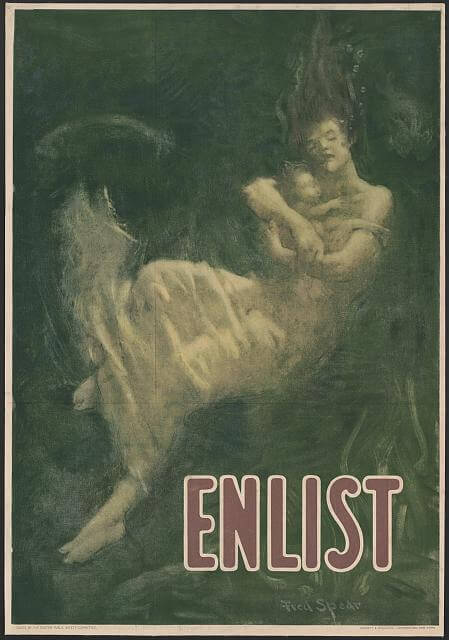
http://www.loc.gov/pictures/resource/ppmsca.50552/
6. Enlist
Fred Spear, 1915
Library of Congress Collection
URL: www.loc.gov/pictures/resource/ppmsca.50552
"Remember Belgium" was a common message of Allied propaganda during World War I. This poster asks the viewer to recall the cruelties of the German forces during the invasion and occupation of Belgium, including the slaughter of thousands of civilians, many of them children. It is estimated that by the end of the war, well over 20,000 Belgian civilians had died at the hands of the Germans. The bulk of the atrocities occurred in the first few months of the war, when invading troops burnt about 25,000 homes. The Allied press, however, was more dogged in its publicization of numerous otherwise unconfirmed incidents of sexual assault and grotesque mutilations of Belgian women and children. These series of real and alleged crimes became known as the "Rape of Belgium." Allied illustrations and posters used the figure of a brutalized woman to symbolize Belgium throughout the war.
Ellsworth Young's poster was produced after the U.S. joined the war in 1917, making it a few years out-of-date. It's disturbing imagery was nonetheless compelling, making it one of the most well-known American posters of the war. By referencing the lurid reports circulating throughout Allied press of German troops brutalizing children, this image solicits the viewer's outrage and pity. A screaming girl, silhouetted against the burning Belgian landscape, is being forcibly dragged off by a German soldier with a spiked helmet and large mustache. The girl is quite young, her size suggesting that she is only around nine or ten years old. This picture also appeared in an 1918 edition of the Ladies' Home Journal, with the caption, "Somebody's little girl. Suppose she were yours. Buy Liberty Bonds to save her."
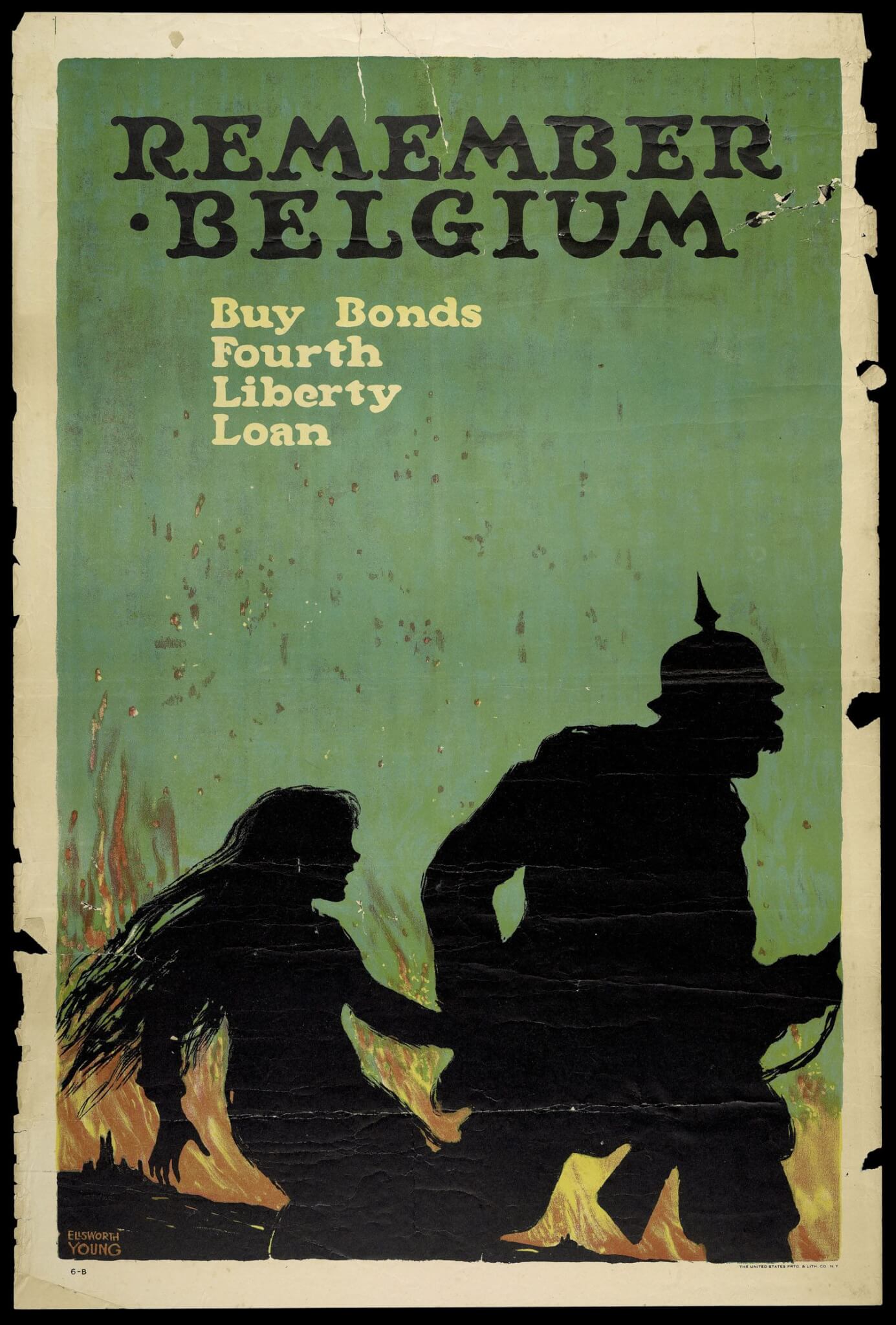
map/43049
7. Remember Belgium
Ellsworth Young, 1917
Robert & Frank Neikirk Collection
URL: www.oshermaps.org/map/43049
The U.S. Food Administration's Education Division produced this poster several months after the country entered the war. Unlike many of its contemporaries, this poster relies on the viewer's sense of duty rather than outrage at injustices committed by the enemy. Below the image of immigrants passing the Statue of Liberty on their way to Ellis Island, the phrase "Your Duty" appears in large capitalized letters. Targeted specifically at immigrants, this poster was distributed in Yiddish and Italian as well as English. The colors used—red, white, and blue—were intended to appeal to the patriotic pride of the new citizens, who are urged to "Remember [their] First Thrill of American Liberty."
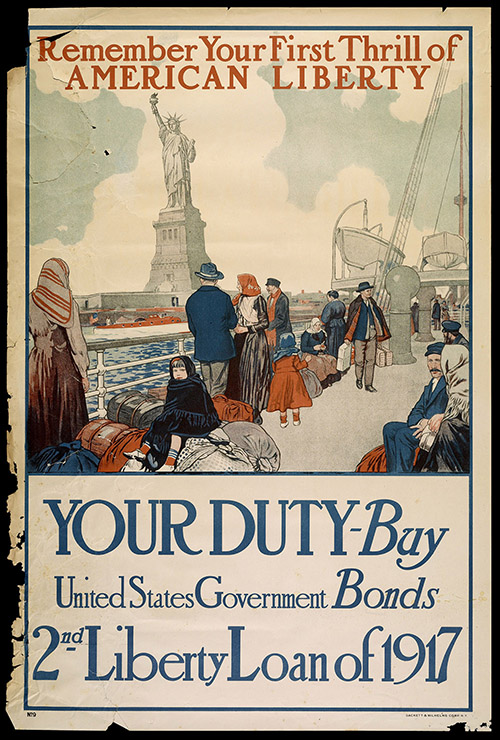
map/42932
8. Remember Your First Thrill of American Liberty
Sackett & Wilhelms Co., 1917
Robert & Frank Neikirk Collection
URL: www.oshermaps.org/map/42932
A bleak contrast to the previous poster (#8), this scene portrays the Statue of Liberty, not gazed on with excitement by newly arrived immigrants, but enveloped in flames. Lady Liberty's torch lies in rubble at her base, and nearby, her head is partially submerged in the waters of New York Harbor. The skyscrapers of the city are discernable in the distance, all subsumed in a massive conflagration. Silhouetted against the fiery sky are bomber planes.
The message of this poster is clear; without victory over the enemy in Europe, war could come home to America. The text below the scene implies that, should the Allied forces fail, liberty may "perish from the Earth." The viewer can help prevent this outcome simply by purchasing Liberty Bonds.
This poster is markedly similar to a set of drawings that appeared in the August 10, 1916 edition of Life Magazine. The first illustration shows the Statue of Liberty and New York City with an ominous caption, "The Unready Nation." The following illustration, titled "The Grave of Liberty," shows a post-destruction scene of the city and statue, in which the buildings are immolated ruins and only the torch of the Statue of Liberty remains, peeking out from the water.
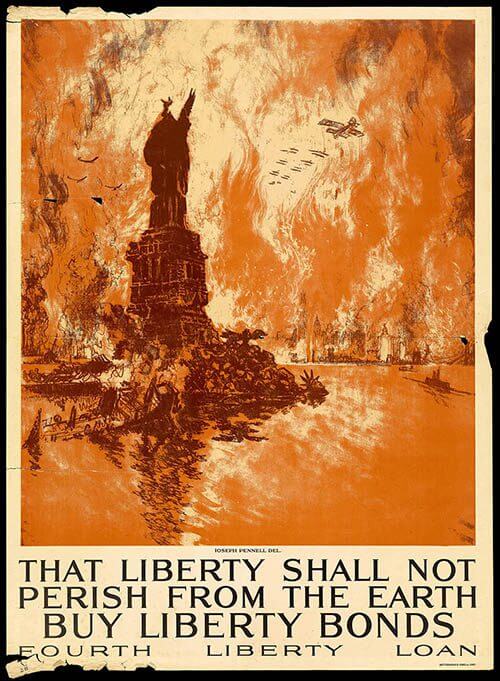
map/42943
9. That Liberty Shall Not Perish from the Earth
Joseph Pennell, 1917
Robert & Frank Neikirk Collection
URL: www.oshermaps.org/map/42943
Woodrow Wilson's round portrait in a bronze decorative border, reminiscent of currency, is the central image of this poster. Presented in large print below the portrait is Wilson's quote regarding the U.S. entrance into World War I: "The time has come to conquer or submit… For us there is but one choice. We have made it." A powerful quote, it employs the viewer's pride and sense of duty and justice.
This quote would soon be appropriated by the Silent Sentinels, a women's suffrage organization created by the famous suffragist, Alice Paul. For two and a half years, beginning before the U.S. entry into the war and ending well after the Armistice, Paul and her fellow suffragists protested in silence outside the White House. The use of silence as a form of protest was strategically effective; their arguments were not presented in the voices of women, so routinely ignored, but in the form of banners, often quoting powerful men. The rhetoric of the Allied officials typically characterized the war as a fight for freedom, for their own countries and for the smaller nations under the German Alliance, while ignoring their own violations of the right to self-determination in their imperial possessions and at home, with the lack of suffrage for the female half of their own citizenry. The banners of the Silent Sentinels called attention to the politicians' hypocrisy, a practice that elicited strong reactions from officials.
On October 20, 1917, Paul carried a banner quoting Woodrow Wilson: "The time has come to conquer or submit, for us there is but one choice. We have made it." She and her compatriots were arrested and sentenced to seven months in prison. This act was later declared unconstitutional by the D.C. Circuit Court of Appeals, although not until the suffragists had spent their time in the Occoquan Workhouse. The women were abused throughout their incarceration, the most famous incident occurring on November 14, 1917, when the prison superintendent ordered the guards to torture the suffragist inmates. The incident became known as the "Night of Terror," with the severe beating of many women, some of whom were then suspended with their hands in chains over their heads, knocked unconscious against iron objects, and choked. One woman, Alice Cosu, suffered a heart attack; Alice Paul herself had already been rendered unable to walk from a long solitary confinement without adequate sustenance. When news of the Night of Terror reached the American public, the resulting outrage caused support for the Suffrage Movement to swell. The women were released two weeks after the Night of Terror and returned to protesting, not stopping until the Nineteenth Amendment was passed by Congress a year and a half later.
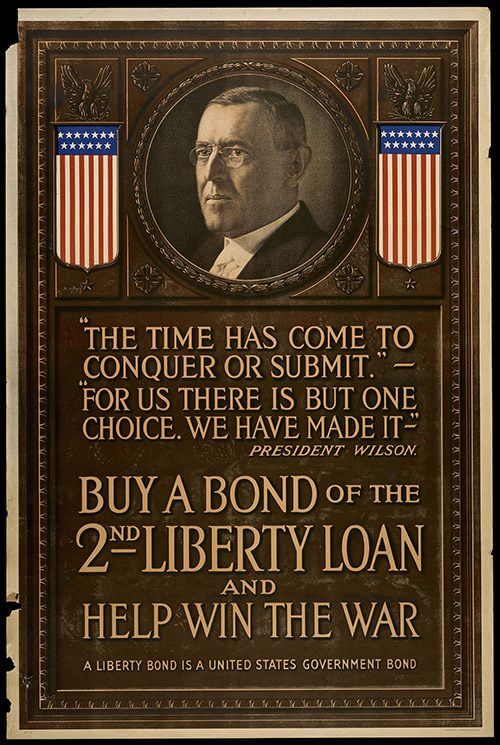
map/42747
10. The Time Has Come to Conquer or Submit
American Lithographic Company, 1917
Robert & Frank Neikirk Collection
URL: www.oshermaps.org/map/42747
Must Children Die and Mothers Plead in Vain? depicts a mother and her two young children crouching amongst ruins. With her left hand raised upward in a pose suggesting supplication, the woman cradles one of her babies in her right arm while another child grasps at her waist. Only a few of the items in the rubble are discernible, including an empty pan and jug to the far right, a reminder of the widespread food shortages and hunger in Europe. In the darker rubble at the left of the poster, an oval shape appears behind the woman's back; although unclear, the shape could be the head of another child, possibly dead.
Like many of the posters featuring women and children, this image aims to elicits pity and, to a lesser degree, guilt from the viewer. It implies that the viewer has a responsibility to provide whatever resources they are able to contribute to bring the war to an earlier end, because the longer the conflict continues, the more women and children will suffer.
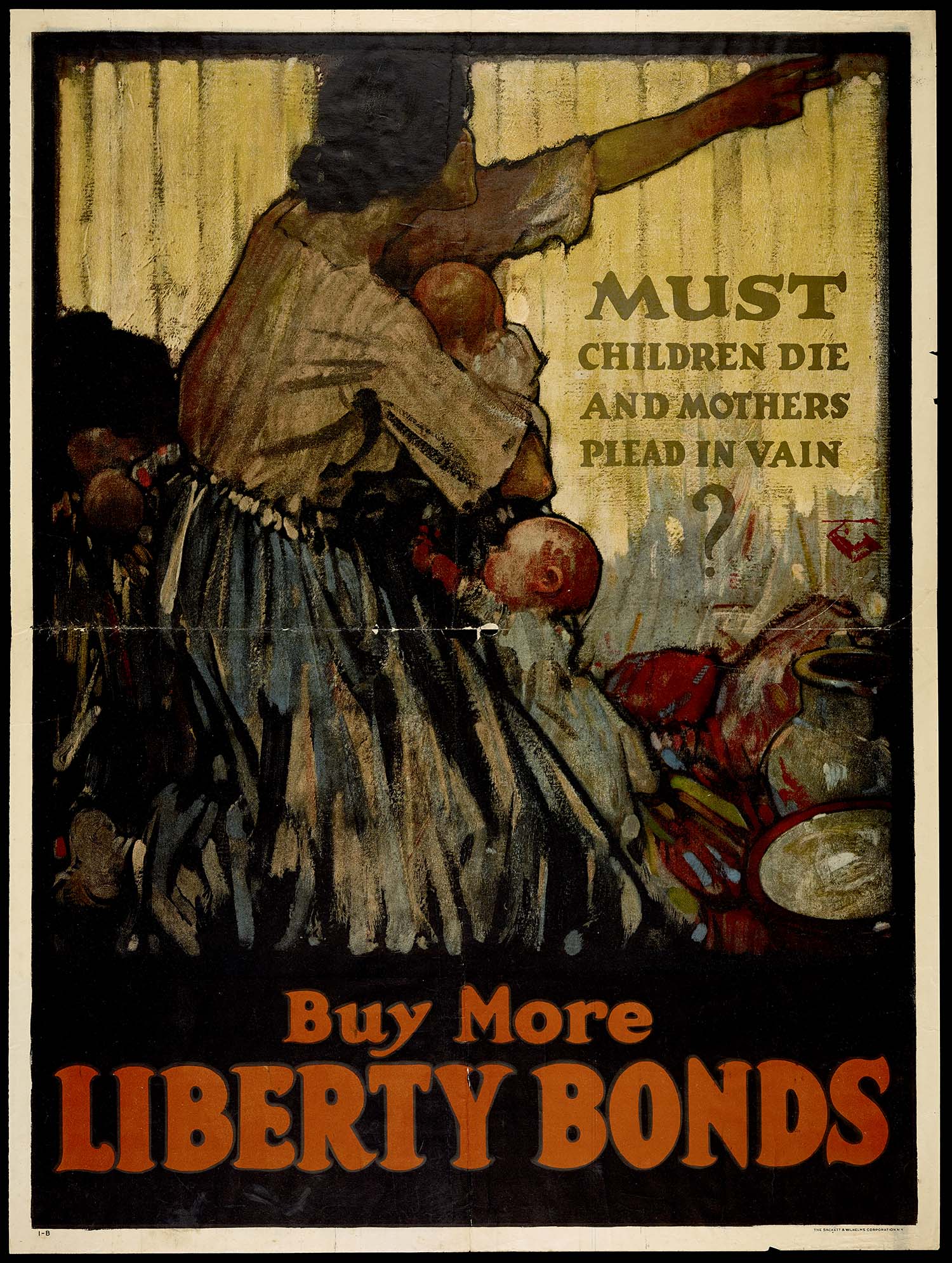
map/43059
11. Must Children Die and Mothers Plead in Vain
Sackett & Wilhelms Co., 1917
Robert & Frank Neikirk Collection
URL: www.oshermaps.org/map/43059
Created by Howard Chandler Christy, a well known illustrator of the early twentieth century, this poster is one of three similar posters each featuring branches of the military. "If you want to fight, join the Marines" and "Fight or Buy War Bonds," which depicts a marching group of Army soldiers (www.oshermaps.org/map/42927), are the other two in the series. Each poster includes a beautiful woman, likely allegorical representations of liberty or America. The personification of liberty in this poster appears to be emerging from the ocean, dressed in white, possibly suggesting innocence, and wearing a laurel wreath, a classical symbol of victory in war. Behind her is an American flag and below her are members of the U.S. Navy in a sea battle, preparing to fire on an unseen enemy target. Barefoot, tattooed, heavily muscled, and universally white and blond, the men are figures of an idealized masculinity. While the explicit message of this poster is "Buy Bonds," another intention, like in Chandler's other two military posters, is to inspire the male viewer to enlist and prove himself to be one of these heroic figures.

map/42748
12. Clear the Way
Howard Chandler Christy, 1917
Robert & Frank Neikirk Collection
URL: www.oshermaps.org/map/42748
This poster uses a dramatic scene of a victim, villain, and hero to capture the viewer's attention. A German soldier looms menacingly over a terrified woman on the ground. With her hair in disarray and her shirt seemingly torn, it is clear that she has already been victimized in some way. In her arms, she cradles a naked, possibly lifeless, child. The villain of the scene wears a spiked helmet and iron cross, one bloody hand holding a bayonet-fitted rifle and the other grabbing the woman's shoulder. The flames in the background give evidence to additional crimes committed by the German. The hero of the scene is an American soldier, who requires only one arm to restrain the villain. Unlike the German soldier, who is hunched and squat with a short neck and protruding jaw, the American stands tall, his chiseled features and confident bearing contrasting sharply with the appearance of the villain. Instead of a rifle, the hero wields a sword more suited to a medieval knight.
The text of the poster uses concise but strong language. "Halt" is also a German word, and "Hun" was the pejorative nickname given to the Germans during World War I. The Huns of the fourth and fifth centuries were a nomadic people in Europe and were considered uncivilized, aggressive, and barbaric. Typically shown with a spiked helmet, bayonet, and bloody hands, the figure of the Hun is prevalent in the Allied propaganda of World War I.
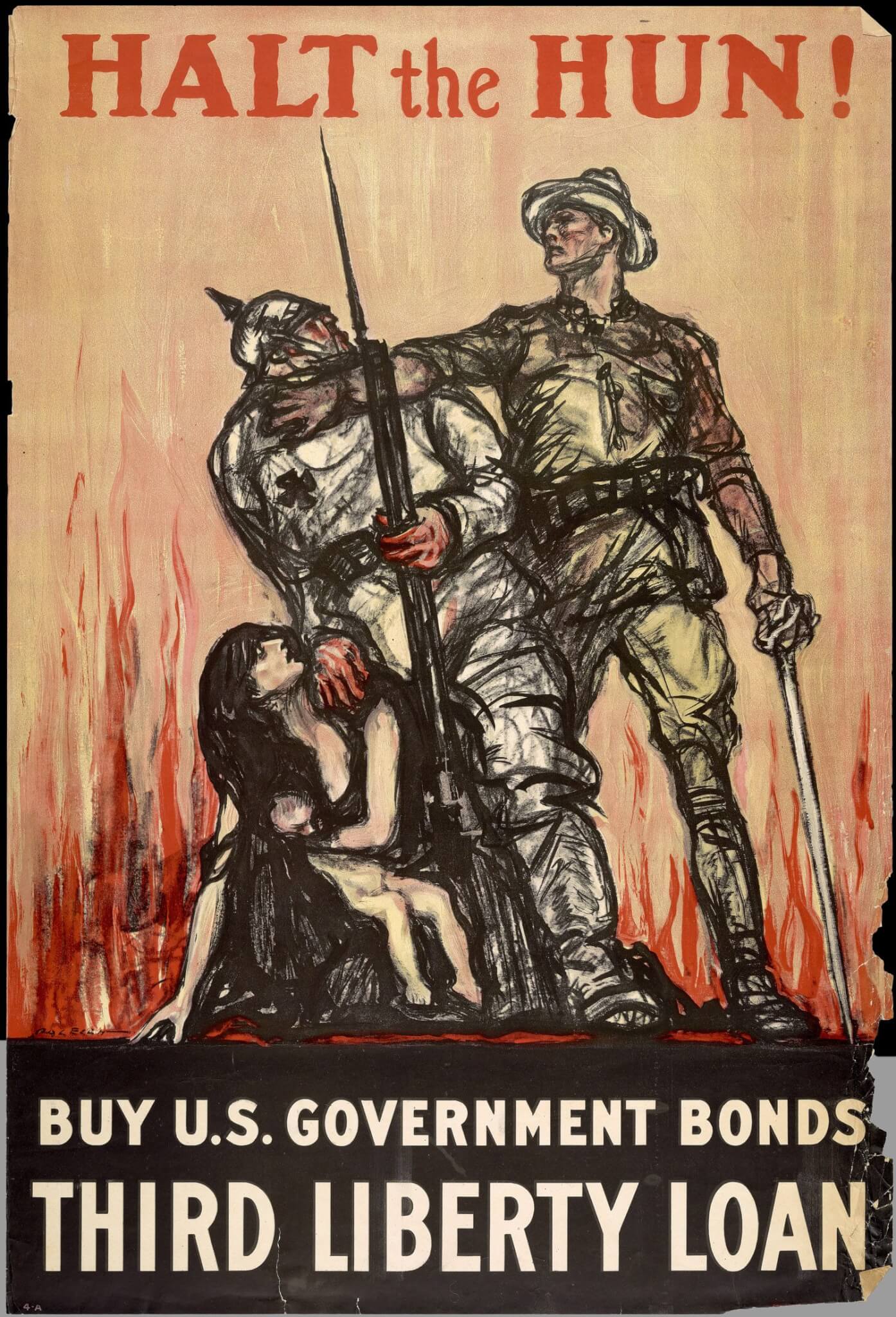
map/42752
13. Halt the Hun
Henry Raleigh, 1917
Robert & Frank Neikirk Collection
URL: www.oshermaps.org/map/42752
Fred Strathmann's poster features one of the more chilling iterations of the Hun figure. Blood drips from his bayonet and hands as he peers with green greedy eyes across the ocean, presumably towards America. Mirroring the frequently used trope of the "skulking Indian" in American print culture at the time, the Hun's hunched posture and black skin can be interpreted as a racial statement. The smoldering ruins of Europe, splattered with blood from the Hun's hands, seem to imply that this could be the America's future if the "Hun" is not defeated. This poster aims to elicit fear and hatred of the enemy, and in doing so, to inspire the viewer to "Beat Back the Hun" and preserve the safety of the nation by buying Liberty Bonds.
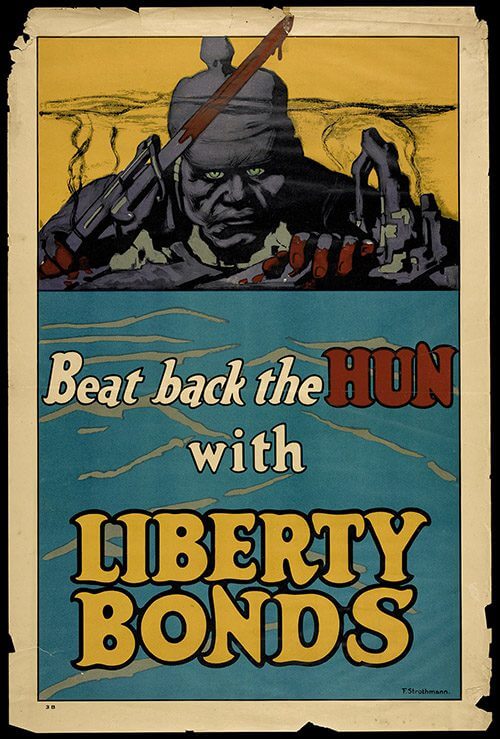
map/42751
14. Beat Back the Hun with Liberty Bonds
Fred Strothman, 1917
Robert & Frank Neikirk Collection
URL: www.oshermaps.org/map/42751